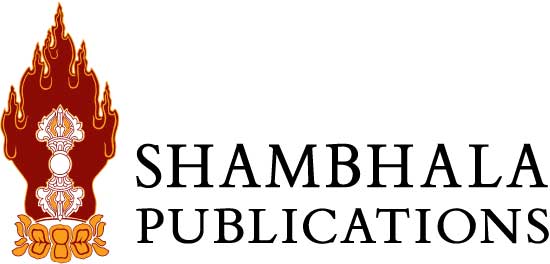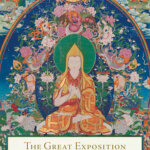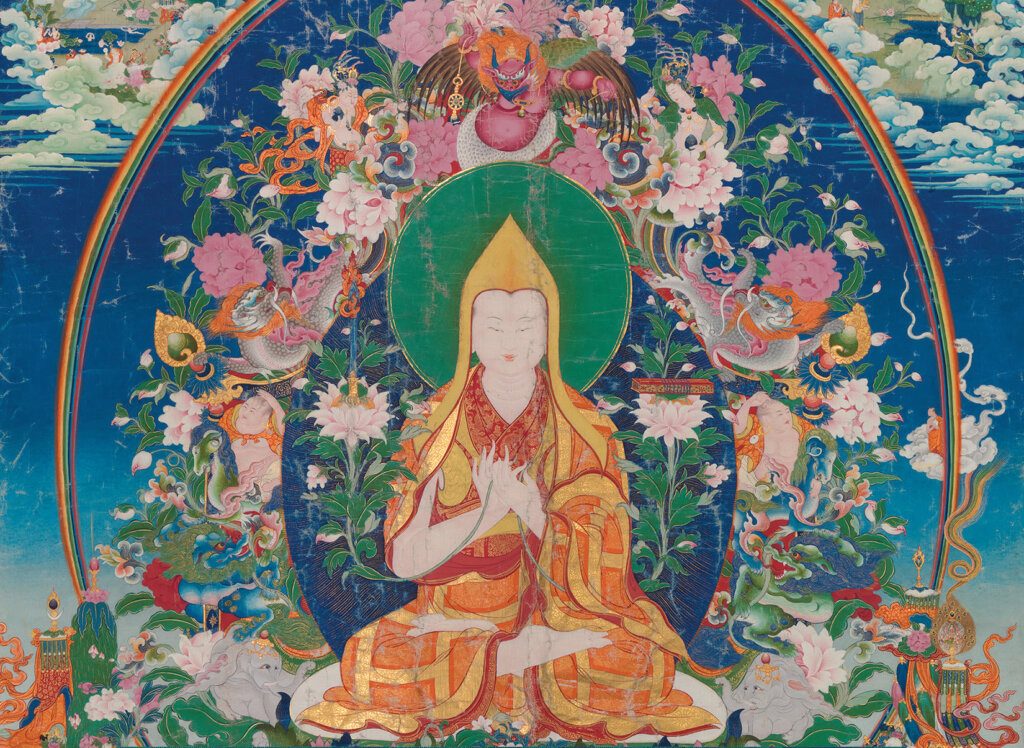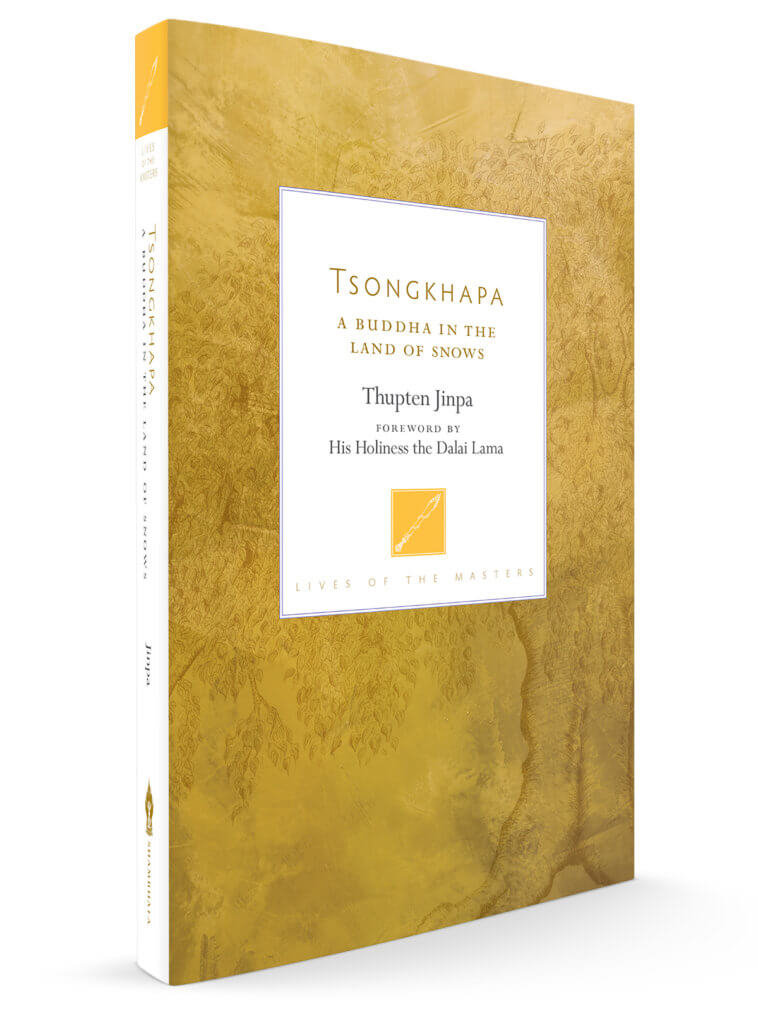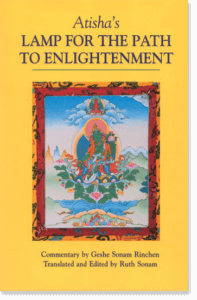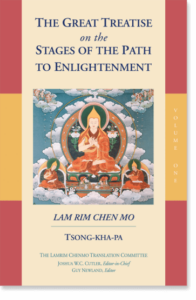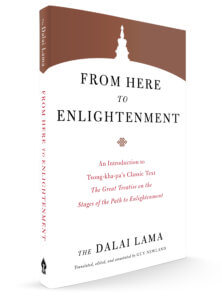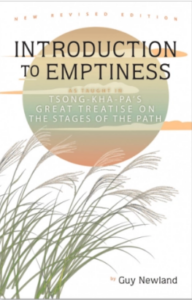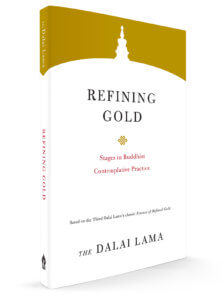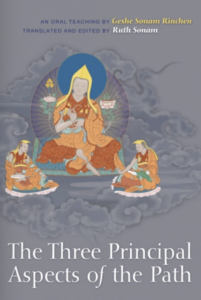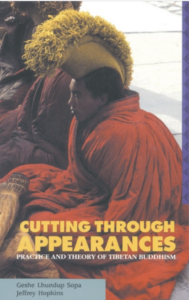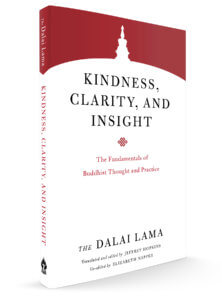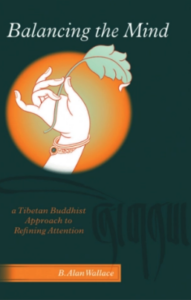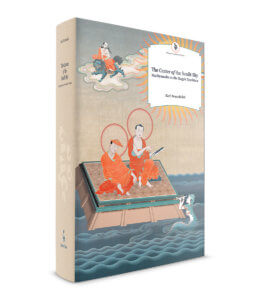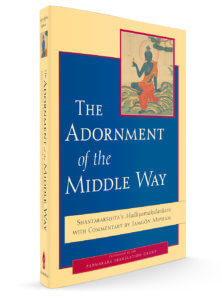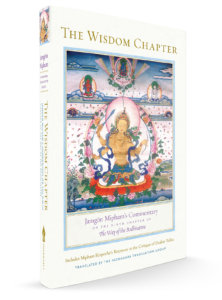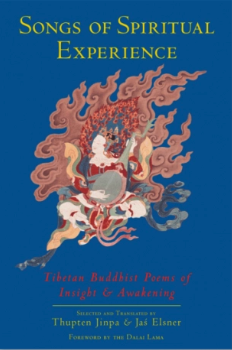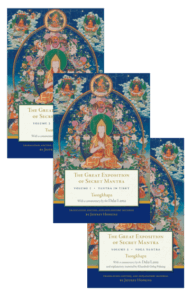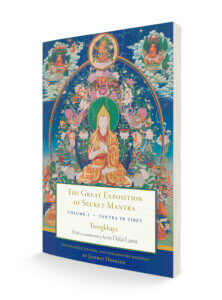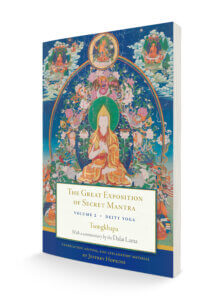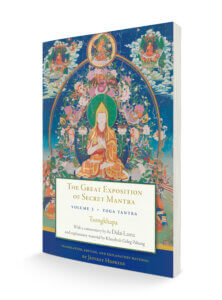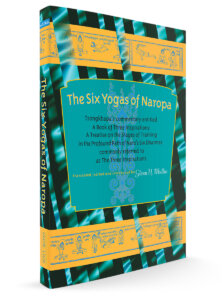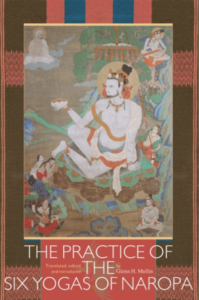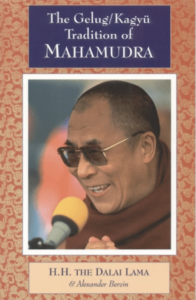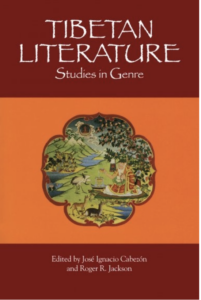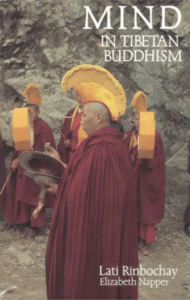The Life of Tsongkhapa Lobsang Drakpa (1357-1419)
Tsongkhapa Lobzang Drakpa (1357–1419), was one of the most important figures in Tibet, historically and philosophically. As the founder of the Gelug school he made an enormous contribution to revitalizing Buddhism in Tibet. Regarded as an emanation of Manjushri--the bodhisattva of wisdom and discerning intelligence, Tsongkhapa was of keen intellect as well as experiential understanding of the Buddhist tradition. He undertook many long retreats during which he had profound visions out of which he wrote many of his celebrated treatises including Lam Rim Chenmo or The Great Exposition of the Stages of the Path. A prolific writer, he composed 210 treatises, compiled into 20 volumes wherein he emphasized the combined paths of Sutra and Tanta. In addition, he established the acclaimed Ganden monastery.
For a longer biography of Tsongkhapa read an excerpt from Geshe Sonam Rinchen's commentary on The Three Principal Aspects of the Path.
The Definitive Biography of Tsongkhapa
Paperback | Ebook
$29.95 - Paperback
Marking the 600th anniversary of Tsongkhapa, in 2019 we published what is the most comprehensive, definitive biography of this great figure, written by Thupten Jinpa. The author is best known as the main translator for the Dalai Lama, but he is an author and scholar himself, having earned a Geshe degree. In the author’s words,
this new biography of Tsongkhapa…is aimed primarily at the contemporary reader. And it seeks to answer the following key questions for them: ‘Who was or is Tsongkhapa? What is he to Tibetan Buddhism? How did he come to assume the deified status he continues to enjoy for the dominant Geluk School of Tibetan Buddhism? What relevance, if any, do Tsongkhapa’s thought and legacy have for our contemporary thought and culture?
—Thupten Jinpa, from the Introduction to Tsongkhapa: A Buddha in the Land of Snows
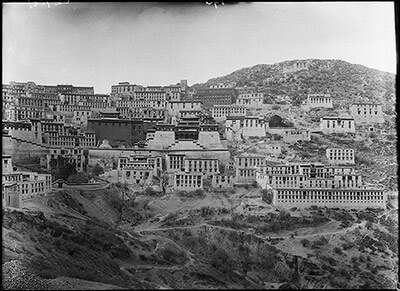
Ganden monastery, founded by Tsongkhapa, photographed in 1921 by Sir Charles Bell
Tsongkhapa's Lam Rim Chenmo, The Great Treatise on the Stages of the Path to Enlightenment
Tsongkhapa's main contribution to this genre is the famous Lamrim Chenmo or The Great Treatise on the Stages of the Path to Enlightenment. It is also generally considered his most influential work, studied and practiced by tens of thousands today.
The background to this work is on one of Tsongkhapa’s own letters to a lama, included in Art Engle's The Inner Science of Buddhist Practice, where he describes it as building on Atisha’s Lamp for the Path to Enlightenment:
“It is clear that this instruction [introduced] by [Atisha] Dīpaṃkara Śrījnāna on the stages of the path to enlightenment . . . teaches [the meanings contained in] all the canonical scriptures, their commentaries, and related instruction by combining them into a single graded path. One can see that when taught by a capable teacher and put into practice by able listeners it brings order, not just to some minor instruction, but to the entire [body of] canonical scriptures. Therefore, I have not taught a wide variety of [other] instructions.”
Paperback | Ebook
$19.95 - Paperback
The Great Treatise on the Stages of the Path to Enlightenment (Vol. 1-3)
The Great Treatise on the Stages of the Path to Enlightenment (Tib. Lam rim chen mo) is one of the brightest jewels in the world’s treasury of sacred literature. The author, Tsong-kha-pa, completed it in 1402, and it soon became one of the most renowned works of spiritual practice and philosophy in the world of Tibetan Buddhism. Because it condenses all the exoteric sūtra scriptures into a meditation manual that is easy to understand, scholars and practitioners rely on its authoritative presentation as a gateway that leads to a full understanding of the Buddha’s teachings.
Tsong-kha-pa took great pains to base his insights on classical Indian Buddhist literature, illustrating his points with classical citations as well as with sayings of the masters of the earlier Kadampa tradition. In this way the text demonstrates clearly how Tibetan Buddhism carefully preserved and developed the Indian Buddhist traditions.
Paperback| Ebook
$34.95 - Paperback
(Volume 1)
By Tsongkhapa
Edited by Joshua Cutler and Guy Newland, Translated by Lamrim Chenmo Translation Committee
This first of three volumes covers all the practices that are prerequisite for developing the spirit of enlightenment (bodhicitta).
Paperback| Ebook
$28.95 - Paperback
(Volume 2)
By Tsongkhapa
Edited by Joshua Cutler and Guy Newland, Translated by Lamrim Chenmo Translation Committee
This second of three volumes covers the deeds of the bodhisattvas, as well as how to train in the six perfections.
Paperback| Ebook
$34.95 - Paperback
(Volume 3)
By Tsongkhapa
Edited by Joshua Cutler and Guy Newland, Translated by Lamrim Chenmo Translation Committee
This third and final volume contains a presentation of the two most important topics in the work: meditative serenity (śamatha) and supramundane insight into the nature of reality (vipaśyanā).
Commentaries on Tsongkhapa's Great Treatise and other Lam Rim (Stages of the Path) texts
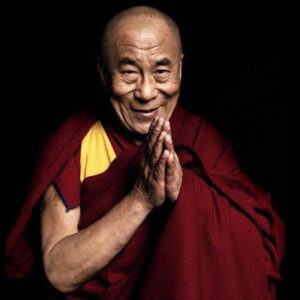
Paperback | Ebook
$19.95 - Paperback
From Here to Enlightenment
An Introduction to Tsong-kha-pa's Classic Text The Great Treatise on the Stages of the Path to Enlightenment
By H.H. The Dalai Lama and translated by Guy Newland
When the Dalai Lama was forced into exile in 1959, he could take only a few items with him. Among these cherished belongings was his copy of Tsong-kha-pa’s classic text The Great Treatise on the Stages of the Path to Enlightenment. This text distills all the essential points of Tibetan Buddhism, clearly unfolding the entire Buddhist path.
In 2008, celebrating the long-awaited completion of the English translation of the Great Treatise, the Dalai Lama gave a historic six-day teaching at Lehigh University to explain the meaning of the text and underscore its importance. It is the longest teaching he has ever given to Westerners on just one text—and the most comprehensive. From Here to Enlightenment makes the teachings from this momentous event available for a wider audience.
Paperback | Ebook
$21.95 - Paperback
Introduction to Emptiness
As Taught in Tsong-kha-pa's Great Treatise on the Stages of the Path
By Guy Newland
Readers are hard-pressed to find books that can help them understand the central concept in Mahayana Buddhism—the idea that ultimate reality is emptiness. In clear language, Introduction to Emptiness explains that emptiness is not a mystical sort of nothingness, but a specific truth that can and must be understood through calm and careful reflection. Newland's contemporary examples and vivid anecdotes will help readers understand this core concept as presented in one of the great classic texts of the Tibetan tradition, Tsong-kha-pa's Great Treatise on the Stages of the Path to Enlightenment. This new edition includes quintessential points for each chapter.
Paperback | Ebook
$17.95 - Paperback
Refining Gold
Stages in Buddhist Contemplative Practice
By H.H. The Dalai Lama
In this extensive teaching, the Dalai Lama beautifully elucidates the meaning of the path to enlightenment through his own direct spiritual advice and personal reflections. Based on two very famous Tibetan text—Tsongkhapa's Song of the Stages on the Spiritual Path and the Third Dalai Lama's Essence of Refined Gold—this teaching presents in practical terms the essential instructions for the attainment of enlightenment. Its direct approach and lucid style make Refining Gold one of the most accessible introductions to Tibetan Buddhism ever published. His discourse draws out the meaning of the Third Dalai Lama’s famous Essence of Refined Gold as he speaks directly to the reader, offering advice, personal reflections, and scriptural commentary. He says in practical terms what the student must do to attain enlightenment.
Tsongkhapa's Three Principle Aspects of the Path
This is the shortest Lamrim text Tsongkhapa composed. Tsongkhapa wrote the fourteen stanzas of this classic distillation of all the paths of practice that lead to enlightenment. The three principal elements of the path referred to are: (1) renunciation, tied to the wish for freedom from cyclic existence; (2) the motivation to attain enlightenment for the benefit of others; (3) cultivating the correct view that realizes emptiness.
Paperback | eBook
$21.95 - Paperback
Three Principal Aspects of the Path
By Geshe Sonam Rinchen, edited and translated by Ruth Sonam
The wish for freedom, the altruistic intention, and the wisdom realizing emptiness constitute the essence of the Buddhist path. In this teaching, Geshe Sonam Rinchen explains, in clear and readily accessible terms, Je Tsongkhapa’s (1357–1419) famed presentation of these three essential topics.
The Three Principal Aspects is also included in Cutting Through Appearances: Practice and Theory of Tibetan Buddhism in which Geshe Sopa annotates the Fourth Panchen Lama’s instructions on how to practice this text in a meditation session.
His Holiness the Dalai Lama teaches on this text, and this is included as the chapter “The Path to Enlightenment” in Kindness, Clarity, and Insight.
Paperback | Ebook
$39.95 - Paperback
Paperback | Ebook
$16.95 - Paperback
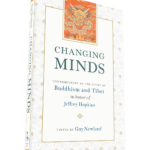
Paperback | eBook
$29.95 - Paperback
Another work where Tsongkhapa’s Lamrim is featured is in Changing Minds: Contributions to the Study of Buddhism and Tibet in Honor of Jeffrey Hopkins. There are three chapters devoted to Tsongkhapa:
- Guy Newland’s Ask a Farmer: Ultimate Analysis and Conventional Existence in Tsongkhapa’s Lam Rim Chen Mo
- Daniel Cozort’s Cutting the Roots of Virtue: Tsongkhapa on the Results of Anger
- Elizabeth Napper’s Ethics as the Basis of a Tantric Tradition: Tsongkhapa and the Founding of the Gelugpa Order
Lotsawa House also includes a translation of these fourteen stanzas.
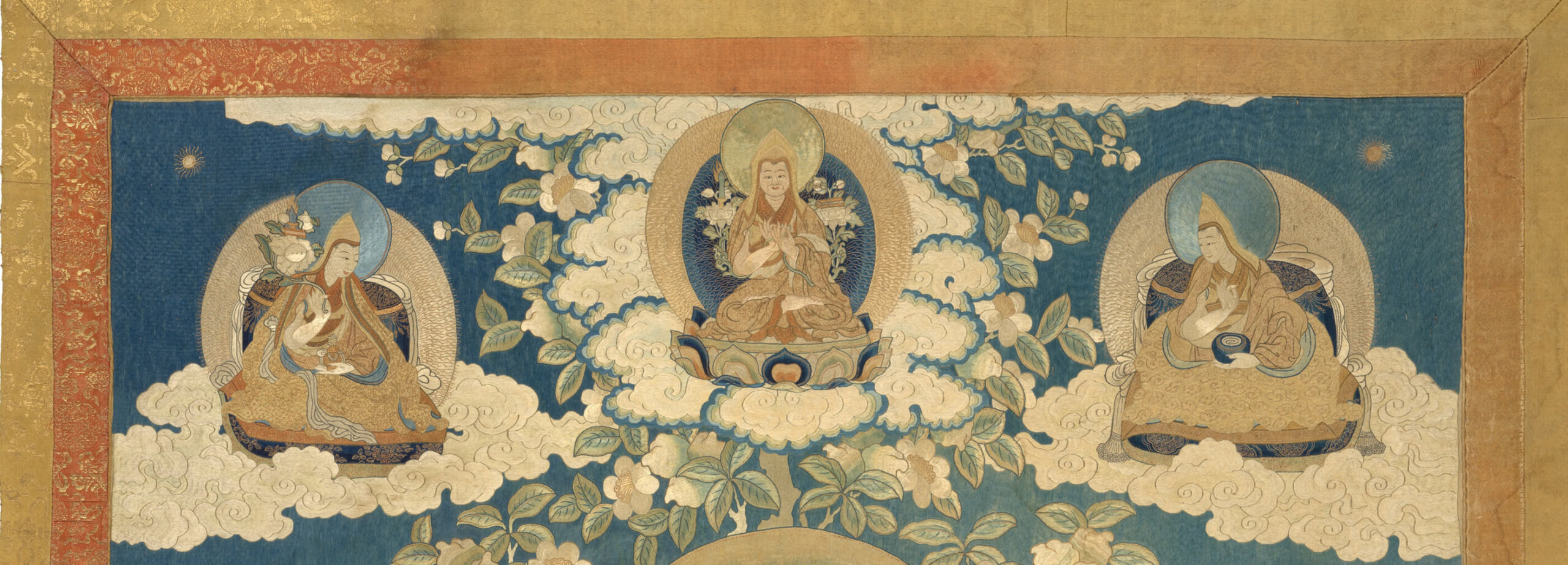
Tsongkhapa on Madhyamaka, The Middle Way School
Tsongkhapa is known for his distinct approach to the middle way philosophical system (madhyamaka) propounded by Indian masters Nāgārjuna (circa 200 CE) and Candrakīrti (circa 600 CE).

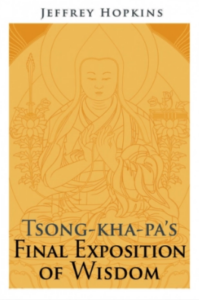
Paperback | eBook
$44.95 - Paperback
Tsong-kha-pa's Final Exposition of Wisdom
By Jeffrey Hopkins
In fourteenth- and fifteenth-century Tibet there was great ferment about what makes enlightenment possible, since systems of self-liberation must show what factors pre-exist in the mind that allow for transformation into a state of freedom from suffering. This controversy about the nature of mind, which persists to the present day, raises many questions. This book first presents the final exposition of special insight by Tsong-kha-pa, the founder of the Ge-luk-pa order of Tibetan Buddhism, in his medium-length Exposition of the Stages of the Path as well as the sections on the object of negation and on the two truths in his Illumination of the Thought: Extensive Explanation of Chandrakirti's Supplement to Nagarjuna's "Treatise on the Middle." It then details the views of his predecessor Dol-po-pa Shay-rap Gyel-tsen, the seminal author of philosophical treatises of the Jo-nang-pa order, as found in his Mountain Doctrine, followed by an analysis of Tsong-kha-pa's reactions. By contrasting the two systems—Dol-po-pa's doctrine of other-emptiness and Tsong-kha-pa's doctrine of self-emptiness—both views emerge more clearly, contributing to a fuller picture of reality as viewed in Tibetan Buddhism. Tsong-kha-pa's Final Exposition of Wisdom brilliantly explicates ignorance and wisdom, explains the relationship between dependent-arising and emptiness, shows how to meditate on emptiness, and explains what it means to view phenomena as like illusions.
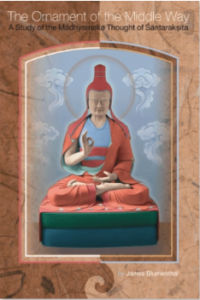
Paperback
$34.95 - Paperback
The Ornament of the Middle Way
A Study of the Madhyamaka Thought of Santaraksita
By James Blumenthal
The late James Blumenthal explores this important text by Shantarakshita and brings in Tsongkhapa’s text on this subject.
Shantarakshita's The Ornament of the Middle Way is among the most important Mahayana Buddhist philosophical treatises to emerge on the Indian subcontinent. In many respects, it represents the culmination of more than 1300 years of philosophical dialogue and inquiry since the time of the historical Buddha Shakyamuni. Shantarakshita set forth the foundation of a syncretic approach to contemporary ideas by synthesizing the three major trends in Indian Buddhist thought at the time (the Madhyamaka thought of Nagarjuna, the Yogachara thought of Asanga, and the logical and epistemological thought of Dharmakirti) into one consistent and coherent system. Shantarakshitas's text is considered to be the quintessential exposition or root text of the school of Buddhist philosophical thought known in Tibet as Yogachara-Svatantrika-Madhyamaka. In addition to examining his ideas in their Indian context, this study examines the way Shantarakshita's ideas have been understood by and have been an influence on Tibetan Buddhist traditions. Specifically, Blumenthal examines the way scholars from the Geluk School of Tibetan Buddhism have interpreted, represented, and incorporated Santaraksita's ideas into their own philosophical project. This is the first book-length study of the Madyamaka thought of Shantarakshita in any Western language. It includes a new translation of Shantarakshita's treatise, extensive extracts from his autocommentary, and the first complete translation of the primary Geluk commentary on Shantarakshita's treatise.
Paperback | eBook
$24.95 - Paperback
Balancing the Mind
A Tibetan Buddhist Approach to Refining Attention
By B. Alan Wallace
For centuries, Tibetan Buddhist contemplatives have directly explored consciousness through carefully honed and rigorous techniques of meditation. B. Alan Wallace explains the methods and experiences of Tibetan practitioners and compares these with investigations of consciousness by Western scientists and philosophers. Balancing the Mind includes a translation of the classic discussion of methods for developing exceptionally high degrees of attentional stability and clarity by fifteenth-century Tibetan contemplative Tsongkhapa.
Tsongkhapa and the Debate over the Two Truths
Tsongkhapa is famous—and in some circles controversial—for his presentation and positioning of the Prasangika view of Madhyamaka. Any discussion or debate of this subject invariably references Tsongkhapa.
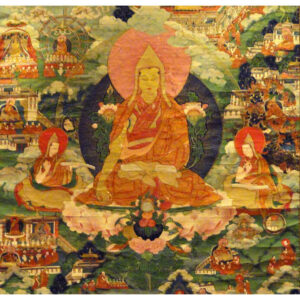
Hardcover | eBook
$78.00 - Hardcover
The Center of a Sunlight Sky
Madhyamaka in the Kagyu Tradition
By Karl Brunnhölzl
This comprehensive work by Karl Brunnholzl explores all facets of Madhyamaka in the Kagyu tradition, but no analysis of Madhyamaka can leave out Tsongkhapa who appears throughout this work. There is a sixty-page section comparing the views of Tsongkhapa to those of Mikyo Dorje’s “whose writing, not only is a reaction to the position of Tsongkhapa and his followers but addresses most of the views on Madhyamaka that were current in Tibet at the time, including the controversial issue of ‘Shentong-Madhyamaka.’”
Paperback| eBook
$39.95 - Paperback
The Adornment of the Middle Way
Shantarakshita's Madhyamakalankara with Commentary by Jamgon Mipham
By Jamgon Mipham, translated by Padmakara Translation Group
For a different take on Shantarakshita's The Ornament of the Middle Way (same text, differently translated title) The Adornment of the Middle Way translated by the Padmakara Translation Group, gives a helpful introduction on the various interpretations. This longer passage offers a glimpse into some of the fault lines in the debate:
The Wisdom Chapter
Jamgön Mipham's Commentary on the Ninth Chapter of The Way of the Bodhisattva
By Jamgon Mipham, translated by Padmakara Translation Group
This work on the Wisdom Chapter of Shantideva’s classic, written more than four centuries after Tsongkhapa, is a presentation of a different view than that expounded by Tsongkhapa. It is, in fact, a superb source for understanding the impact of his Madhyamaka presentation in a wider context, historically and philosophically. The extensive introduction gives a very complete and comprehensive account. In sum:
Tsongkhapa's Poetry and Songs of Realization
Paperback
$22.95 - Paperback
Thupten Jinpa’s collection of Tibetan poetry includes two poems by Tsongkhapa including Reflections on Emptiness, which is extracted from a larger work, the rTag tu ngu’i rtogs brjod—a poetic retelling of the story of the bodhisattva Sadāprarudita, who is associated with the 8,000 Verse Prajnamaramita Sutra and A Prayer for the Flourishing of Virtues.
Jinpa presents Tsongkhapa’s poetry first in terms of his mastery of composition and second, in terms of his mastery of the Buddhist path.
First, describing his master of composition, Jinpa writes:
Tsongkhapa’s famous long poem entitled ‘‘A Literary Gem of Poetry’’ uses a single vowel in every stanza throughout the entire length. This is the poem from which come the famous lines:
Good and evil are but states of the heart:
When the heart is pure, all things are pure;
When the heart is tainted, all things are tainted.
So all things depend on your heart.In the original Tibetan, this stanza uses only the vowel a. Of course, this kind of literary device can never be reproduced in a translation, whatever the virtuosity and command of the translator.
Second, describing his mastery of the Buddhist path Jinpa states:
To a contemporary reader, Tsongkhapa’s famous ‘‘Prayer for the Flourishing of Virtues’’ gives an insight into the deepest ideals of a dedicated Tibetan Buddhist practitioner; it presents a map of progressive development on the path. Beyond this, the mystic must utterly transform the very root of his identity and the perceptions that arise from it. From the ordinary patterns of action and reaction that make up our psyche and emotional life, the meditator must move toward a divine state of altered consciousness where all realities, including one’s own self, are manifested in their enlightened forms. In other words, the meditator must perfect all dimensions of his or her identity and experience, including rationality, emotion, intuition, and even sexuality. This, in Tibetan Buddhism, is the mystical realm of tantra.
Tsongkhapa and Tantra
A brief note. For those unfamiliar or only exposed through books, we strongly encourage readers to study tantra under the guidance of a qualified teacher. Book reading can only take you so far as the transmission of tantric teaching is about more than what can be put on paper.
This work is analogous to the tantra version of the Lamrim Chenmo, presenting tantra from the position of the sarma, ie., the 'new school,' or later transmission from India.
There are three books by Tsongkhapa and His Holiness the Dalai Lama that form a series focused on Tsongkhapa's Great Exposition of Secret Mantra. In this text, Tsongkhapa presents the differences between sutra and tantra and the main features of various systems of tantra. Each of the three books below begins with the Dalai Lama contextualizing and commenting on the points presented in Tsongkhapa's text, followed by a translation of the corresponding part of the text itself.
Paperback
$29.95 - Paperback
In Volume 1: Tantra in Tibet, the foundations of motivation, refuge, and the Hinayana and Mahayana paths are presented. He then gives an overview of tantra, the notion of Clear Light, the greatness of mantra, and initiation or empowerment.
This revised work describes the differences between the Great Vehicle and Lesser Vehicle streams in the sutra tradition, and between the sutra tradition and that of tantra generally. It includes highly practical and compassionate explanations from H.H. the Dalai Lama on tantra for spiritual development; the first part of the classic Great Exposition of Secret Mantra text; and a supplement by Jeffrey Hopkins on the difference between the Vehicles, emptiness, psychological transformation, and the purpose of the four tantras.
Paperback
$29.95 - Paperback
In Volume II: Deity Yoga, His Holiness discusses deity yoga at length with a particular focus on action and performance tantras (the first two categories of tantra as described in the sarma, or “new translation” schools).
This revised work describes the profound process of meditation in Action (kriya) and Performance (carya) Tantras. Invaluable for anyone who is practicing or is interested in Buddhist tantra, this volume includes a lucid exposition of the meditative techniques of deity yoga from H.H. the Dalai Lama; the second and third chapters of the classic Great Exposition of Secret Mantra text; and a supplement by Jeffrey Hopkins outlining the structure of Action Tantra practices as well as the need for the development of special yogic powers.
Paperback
$27.95 - Paperback
in Volume III: Yoga Tantra the Dalai Lama details the practice of the next level of tantra, yoga tantra. With a preliminary overview of the motivation, His Holiness explains this level, which focuses on internal yoga, which here means the union of deity yoga with the wisdom of realizing emptiness. He details the yoga, both that with and that without signs, and then briefly explains how gaining stability in these practices is the foundation for some other practices that lead to mundane and extraordinary “feats.”
This work opens with the Dalai Lama presenting the key features of Yoga Tantra then continues with the root text by Tsongkhapa. This is followed by an overview of the central practices by Khaydrub Je. Jeffrey Hopkins concludes the volume with an outline of the steps of Yoga Tantra practice, which is drawn from the Dalai Lama’s, Tsongkhapa’s, and Khaydrub Je’s explanations.
Paperback
$39.95 - Paperback
The Six Yogas of Naropa
Tsongkhapa's Commentary
By Glenn H. Mullin
Tsongkhapa's commentary entitled A Book of Three Inspirations: A Treatise on the Stages of Training in the Profound Path of Naro's Six Dharmas is commonly referred to as The Three Inspirations. Anyone who has read more than a few books on Tibetan Buddhism will have encountered references to the Six Yogas of Naropa, a preeminent yogic technology system. The six practices—inner heat, illusory body, clear light, consciousness transference, forceful projection, and bardo yoga—gradually came to pervade thousands of monasteries, nunneries, and hermitages throughout Central Asia over the past five and a half centuries.
Paperback
$27.95 - Paperback
The Practice of the Six Yogas of Naropa
By Glenn H. Mullin
Another text that is included in Tsongkhapa’s collected works is the short Practice Manual on the Six Yogas. This is included in the wider collection of texts on this practice titled The Practice of the Six Yogas of Naropa. Also included in this book are works by Tilopa, Naropa, Je Sherab Gyatso, and the First Panchen Lama.

Paperback | eBook
$39.95 - Paperback
This work has three main sections: an overview of Mahamudra, the First Panchen’s text The Main Road of the Triumphant Ones, and a commentary by the Dalai Lama. The author contextualizes the selection saying that the tradition of Mahamudra in the Gelug tradition comes through Tsongkhapa.
Other Notable Works Related to Tsongkhapa
Paperback | eBook
$39.95 - Paperback
Tibetan Literature
Studies in Genre
Edited by Jose Cabezon and Roger R. Jackson
Tibetan Literature: Studies in Genre is a collection by leading Tibetologists. The immensity of Tibet's literary heritage, unsurprisingly, is filled with references to Tsongkhapa across a wide range of subjects. Just a sampling of them include: the establishment of the Gelug order; the monastic curriculum; debate manuals; establishment of Ganden; a comparison with Milarepa; the controversies about his views; a classification of his texts; and a lot more.
Paperback | eBook
$29.95 - Paperback
Mind in Tibetan Buddhism
By Lati Rinpoche, Edited and translated by Elizabeth Napper
Mind in Tibetan Buddhism is an oral commentary on Geshe Jampel Sampel's Presentation of Awareness and Knowledge Composite of All the Important Points, Opener of the Eye of New Intelligence. This topic, lorig in Tibetan, was not one on which Tsongkhapa wrote a dedicated text, but he does include it in an introduction to Dharmakirti’s Seven Treatises and one of his sections includes a brief presentation on lorig. Tsongkhapa is brought up throughout this book.
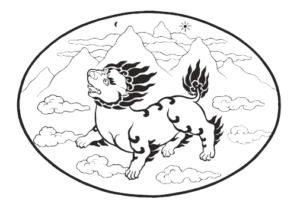
Tsongkhapa is also referenced in about 60 articles on shambhala.com, mostly from the Snow Lion newsletter archive.
Additional Resources


More can be found on Atisha's life on Treasury of Lives
